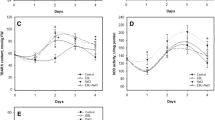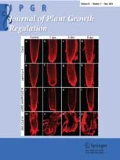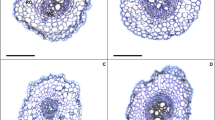Abstract
The brassinosteroids (BRs) constitute a recently defined class of plant hormone that can enhance the resistance of plants to multiple stresses. However, the effects of BRs on salt-stressed woody plants, notably on photosynthesis and chloroplast ultrastructure, have received little attention. Black locust (Robinia pseudoacacia L.) seeds and seedlings were pretreated with 1.04 µmol L− 1 24-epibrassinolide (24-epiBL) by soaking and root dipping, respectively, and grown under non-saline or saline conditions (0, 100, 200 mmol L− 1 NaCl). Salinity stress decreased photosynthesis, chlorophyll concentration, transpiration, and stomatal conductance but also decreased the water-use efficiency, while chlorophyll fluorescence indicated a decrease in photochemical quenching and in maximum potential quantum efficiency. Indicators of oxidative stress (for example, H2O2 and antioxidant enzymes), membrane leakage, and amounts of Na+ ions in leaves and chloroplasts were increased and, at the highest stress, chloroplast ultrastructure was severely disrupted. Exogenous 24-epiBL improved membrane stability and reduced foliar Na+ levels, while substantially alleviating stress-induced changes in photosynthetic gas exchange. Improvements in chlorophyll content and indicators of oxidative stress were not as large but were still highly significant. Thylakoid membrane structure was protected. Both methods of applying 24-epiBL were effective, but root-dipped seedlings performed marginally better. The results suggest that treatment of black locust seedlings with 24-epiBL prior to planting may improve performance and aid establishment on salt-affected soils.





Similar content being viewed by others

References
Abo-Ogiala A, Carsjens C, Diekmann H, Fayyaz P, Herrfurth C, Feussner I, Polle A (2014) Temperature-induced lipocalin (TIL) is translocated under salt stress and protects chloroplasts from ion toxicity. J Plant Physiol 171:250–259. https://doi.org/10.1016/j.jplph.2013.08.003
Agrawal R, Gupta S, Gupta NK, Khandelwal SK, Bhargava R (2013) Effect of sodium chloride on gas exchange, antioxidative defense mechanism and ion accumulation in different cultivars of Indian jujube (Ziziphus mauritiana L.). Photosynthetica 51:95–101. https://doi.org/10.1007/s11099-013-0003-8
Ahammed GJ, Ruan YP, Zhou J, Xia XJ, Shi K, Zhou YH, Yu JQ (2013) Brassinosteroid alleviates polychlorinated biphenyls-induced oxidative stress by enhancing antioxidant enzymes activity in tomato. Chemosphere 90:2645–2653. https://doi.org/10.1016/j.chemosphere.2012.11.041
Akatov VV, Akatova TV, Shadzhe AE (2016) Robinia pseudoacacia L. in the Western Caucasus. Russ J Biol Invasions 7:105–118. https://doi.org/10.1134/S2075111716020028
Ali B, Hayat S, Fariduddin Q, Ahmad A (2008a) 24-Epibrassinolide protects against the stress generated by salinity and nickel in Brassica juncea. Chemosphere 72:1387–1392. https://doi.org/10.1016/j.chemosphere.2008.04.012
Ali Q, Athar HUR, Ashraf M (2008b) Modulation of growth, photosynthetic capacity and water relations in salt stressed wheat plants by exogenously applied 24-epibrassinolide. Plant Growth Regul 56:107–116. https://doi.org/10.1007/s10725-008-9290-7
Arnon D (1949) Copper enzymes in isolated chloroplasts. Polyphenoloxidase in Beta vulgaris. Plant Physiol 20:1–16
Azhar N, Su N, Shabala L, Shabala S (2017) Exogenously applied 24-epibrassinolide (EBL) ameliorates detrimental effects of salinity by reducing K+ efflux via depolarization-activated K+ channels. Plant Cell Physiol 58:802–810. https://doi.org/10.1093/pcp/pcx026
Bartels D, Sunkar R (2005) Drought and salt tolerance in plants. CRC Crit Rev Plant Sci 24:23–58. https://doi.org/10.1080/07352680590910410
Beyer WF, Fridovich I (1987) Assaying for superoxide dismutase activity: some large consequences of minor changes in conditions. Anal Biochem 161:559–566. https://doi.org/10.1016/0003-2697(87)90489-1
Cerović ZG, Plesnicar M (1984) An improved procedure for the isolation of intact chloroplasts of high photosynthetic capacity. Biochem J 223:543–545
Choudhary SP, Kanwar M, Bhardwaj R, Gupta BD, Gupta RK (2011) Epibrassinolide ameliorates Cr (VI) stress via influencing the levels of indole-3-acetic acid, abscisic acid, polyamines and antioxidant system of radish seedlings. Chemosphere 84:592–600. https://doi.org/10.1016/j.chemosphere.2011.03.056
Cui L, Zou Z, Zhang J, Zhao Y, Yan F (2016) 24-Epibrassinoslide enhances plant tolerance to stress from low temperatures and poor light intensities in tomato (Lycopersicon esculentum Mill.). Funct Integr Genomics 16:29–35. https://doi.org/10.1007/s10142-015-0464-x
DeGomez T, Wagner MR (2001) Culture and use of black locust. Horttechnology 11:279–288
Diao M, Ma L, Wang J, Cui J, Fu A, Liu H (2014) Selenium promotes the growth and photosynthesis of tomato seedlings under salt stress by enhancing chloroplast antioxidant defense system. J Plant Growth Regul 33:671–682. https://doi.org/10.1007/s00344-014-9416-2
Divi UK, Krishna P (2009) Brassinosteroid: a biotechnological target for enhancing crop yield and stress tolerance. N Biotechnol 26:131–136. https://doi.org/10.1016/j.nbt.2009.07.006
Ellis T, van Dijk A (2009) Agroforestry for the management of water, salt and agricultural diffuse source pollutants. In: Nuberg I, George B, Reid R (eds) Agroforestry for natural resource management. CSIRO, Collingwood, pp 53–68
Flexas J, Medrano H (2002) Drought-inhibition of photosynthesis in C3 plants: stomatal and non-stomatal limitations revisited. Ann Bot 89:183–189. https://doi.org/10.1093/aob/mcf027
Gao HJ, Yang HY, Bai JP, Liang XY, Lou Y, Zhang JL, Wang D, Zhang JL, Niu SQ, Chen YL (2014) Ultrastructural and physiological responses of potato (Solanum tuberosum L.) plantlets to gradient saline stress. Front Plant Sci 5:787. https://doi.org/10.3389/fpls.2014.00787
Gengmao Z, Shihui L, Xing S, Yizhou W, Zipan C (2015) The role of silicon in physiology of the medicinal plant (Lonicera japonica L.) under salt stress. Sci Rep 5:12696. https://doi.org/10.1038/srep12696
Grove MD, Spencer GF, Rohwedder WK, Mandava N, Worley JF, Warthen JD Jr, Steffens GL, Flippen-Anderson JL, Cook JC Jr (1979) Brassinolide, a plant growth-promoting steroid isolated from Brassica napus pollen. Nature 281:216–217
Hajibagheri MA, Flowers TJ (1984) Photosynthetic oxygen evolution in relation to ion contents in the chloroplasts of Suaeda maritima. Plant Sci Lett 34:353–362
Hamada K (1986) Brassinolide in crop cultivation. Plant growth regulators in agriculture. FFTC Book Ser 34:188–196
Hayat S, Ali B, Hasan SA, Ahmad A (2007) Brassinosteroid enhanced the level of antioxidants under cadmium stress in Brassica juncea. Environ Exp Bot 60:33–41. https://doi.org/10.1016/j.envexpbot.2006.06.002
Hayat S, Hasan SA, Yusuf M, Hayat Q, Ahmad A (2010) Effect of 28-homobrassinolide on photosynthesis, fluorescence and antioxidant system in the presence or absence of salinity and temperature in Vigna radiata. Environ Exp Bot 69:105–112. https://doi.org/10.1016/j.envexpbot.2010.03.004
Heath RL, Packer L (1968) Photoperoxidation in isolated chloroplasts. Arch Biochem Biophys 125:189–198. https://doi.org/10.1016/0003-9861(68)90654-1
Hoagland DR, Arnon DI (1950) The water-culture method for growing plants without soil. Calif Agric Exp Stn Circ 347:1–32. doi: citeulike-article-id:9455435
Hu L, Xiang L, Zhang L, Zhou X, Zou Z, Hu X (2014) The photoprotective role of spermidine in tomato seedlings under salinity-alkalinity stress. PLoS ONE 9:e110855. https://doi.org/10.1371/journal.pone.0110855
Jiang YP, Huang LF, Cheng F, Zhou YH, Xia XJ, Mao WH, Shi K, Yu JQ (2013) Brassinosteroids accelerate recovery of photosynthetic apparatus from cold stress by balancing the electron partitioning, carboxylation and redox homeostasis in cucumber. Physiol Plant 148:133–145. https://doi.org/10.1111/j.1399-3054.2012.01696.x
Kalaji HM, Govindjee, Bosa K, Kościelniak J, Żuk-Gołaszewska K (2011) Effects of salt stress on photosystem II efficiency and CO2 assimilation of two Syrian barley landraces. Environ Exp Bot 73:64–72. https://doi.org/10.1016/j.envexpbot.2010.10.009
Kemmerling B, Schwedt A, Rodriguez P, Mazzotta S, Frank M, Qamar SA, Mengiste T, Betsuyaku S, Parker JE, Müssig C, Thomma BPHJ, Albrecht C, de Vries SC, Hirt H, Nürnberger T (2007) The BRI1-associated kinase 1, BAK1, has a brassinolide-independent role in plant cell-death control. Curr Biol 17:1116–1122. https://doi.org/10.1016/j.cub.2007.05.046
Li YH, Liu YJ, Xu XL, Jin M, An LZ, Zhang H (2012) Effect of 24-epibrassinolide on drought stress-induced changes in Chorispora bungeana. Biol Plant 56:192–196. https://doi.org/10.1007/s10535-012-0041-2
Li JY, Zhao CY, Li J, Yan YY, Yu B, Han M (2013) Growth and leaf gas exchange in Populus euphratica across soil water and salinity gradients. Photosynthetica 51:321–329. https://doi.org/10.1007/s11099-013-0028-z
Li J, Pu L, Han M, Zhu M, Zhang R, Xiang Y (2014) Soil salinization research in China: advances and prospects. J Geogr Sci 24:943–960. https://doi.org/10.1007/s11442-014-1130-2
Li X, Ahammed GJ, Li ZX, Zhang L, Wei JP, Shen C, Yan P, Zhang LP, Han WY (2016) Brassinosteroids improve quality of summer tea (Camellia sinensis L.) by balancing biosynthesis of polyphenols and amino acids. Front Plant Sci 7:1304. https://doi.org/10.3389/fpls.2016.01304
Liu WN, Jiang HY, Yang MS (2010) Selection of salt-tolerance on Robinia pseudoacacia seedings and impact of salt stress on seedlings’ physiological characteristics. J Agric Univ Hebei 3:62–66. (in Chinese)
Luo Z, Li K, Gai Y, Göbel C, Wildhagen H, Jiang X, Feußner I, Rennenberg H, Polle A (2011) The ectomycorrhizal fungus (Paxillus involutus) modulates leaf physiology of poplar towards improved salt tolerance. Environ Exp Bot 72:304–311. https://doi.org/10.1016/j.envexpbot.2011.04.008
Milla-Moreno EA, McKown AD, Guy RD, Soolanayakanahally RY (2016) Leaf mass per area predicts palisade structural properties linked to mesophyll conductance in balsam poplar (Populus balsamifera L.). Botany 94:225–239. https://doi.org/10.1139/cjb-2015-0219
Mitchell JW, Mandava N, Worley JF, Plimmer JR, Smith MV (1970) Brassins—a new family of plant hormones from rape pollen. Nature 225:563–564
Mittler R (2002) Oxidative stress, antioxidants and stress tolerance. Trends Plant Sci 7:405–410. https://doi.org/10.1016/S1360-1385(02)02312-9
Nakano Y, Asada K (1981) Hydrogen peroxide is scavenged by ascorbate-specific peroxidase in spinach chloroplasts. Plant Cell Physiol 22:867–880. https://doi.org/10.1093/oxfordjournals.pcp.a076232
Oxborough K (2004) Imaging of chlorophyll a fluorescence: theoretical and practical aspects of an emerging technique for the monitoring of photosynthetic performance. J Exp Bot 55:1195–1205. https://doi.org/10.1093/jxb/erh145
Park CH, Kim TW, Son SH, Hwang JY, Lee SC, Chang SC, Kim SH, Kim SW, Kim SK (2010) Brassinosteroids control AtEXPA5 gene expression in Arabidopsis thaliana. Phytochemistry 71:380–387. https://doi.org/10.1016/j.phytochem.2009.11.003
Patterson BD, MacRae EA, Ferguson IB (1984) Estimation of hydrogen peroxide in plant extracts using titanium (IV). Anal Biochem 139:487–492. https://doi.org/10.1016/0003-2697(84)90039-3
Qadir M, Oster JD (2004) Crop and irrigation management strategies for saline-sodic soils and waters aimed at environmentally sustainable agriculture. Sci Tot Environ 323:1–19. https://doi.org/10.1016/j.scitotenv.2003.10.012
Rahmonov O (2009) The chemical composition of plant litter of black locust (Robinia pseudoacacia L.) and its ecological role in sandy ecosystems. Shengtai Xuebao/Acta Ecol Sin 29:237–243. https://doi.org/10.1016/j.chnaes.2009.08.006
Ramakrishna B, Rao SSR (2012) 24-Epibrassinolide alleviated zinc-induced oxidative stress in radish (Raphanus sativus L.) seedlings by enhancing antioxidative system. Plant Growth Regul 68:249–259. https://doi.org/10.1007/s10725-012-9713-3
Roháček K (2002) Chlorophyll fluorescence parameters: the definitions, photosynthetic meaning, and mutual relationships. Photosynthetica 40:13–29. https://doi.org/10.1023/A:1020125719386
Sairam RK (1994) Effects of homobrassinolide application on plant metabolism and grain yield under irrigated and moisture-stress conditions of two wheat varieties. Plant Growth Regul 306:173–181. https://doi.org/10.1007/BF00025220
Sayed OH (2003) Chlorophyll fluorescence as a tool in cereal crop research. Photosynthetica 41:321–330. https://doi.org/10.1023/B:PHOT.0000015454.36367.e2
Shahid SA (2013) Developments in soil salinity assessment, modeling, mapping and monitoring from regional to submicroscopic scales. In: Shahid SA, Abdelfattah MA, Taha FK (eds) Developments in soil salinity assessment and reclamation. Springer, Dordrecht, pp 3–43. https://doi.org/10.1007/978-94-007-5684-7
Sharma I, Kaur N, Pati PK (2017) Brassinosteroids: a promising option in deciphering remedial strategies for abiotic stress tolerance in rice. Front Plant Sci 8:2151. https://doi.org/10.3389/fpls.2017.02151
Shu S, Yuan LY, Guo SR, Sun J, Yuan YH (2013) Effects of exogenous spermine on chlorophyll fluorescence, antioxidant system and ultrastructure of chloroplasts in Cucumis sativus L. under salt stress. Plant Physiol Biochem 63:209–216. https://doi.org/10.1016/j.plaphy.2012.11.028
Sitzia T, Campagnaro T, Dainese M, Cierjacks A (2012) Plant species diversity in alien black locust stands: a paired comparison with native stands across a north-Mediterranean range expansion. For Ecol Manag 285:85–91. https://doi.org/10.1016/j.foreco.2012.08.016
Song XS, Tiao CL, Shi K, Mao WH, Ogweno JO, Zhou YH, Yu JQ (2006) The response of antioxidant enzymes in cellular organelles in cucumber (Cucumis sativus L.) leaves to methyl viologen-induced photo-oxidative stress. Plant Growth Regul 49:85–93. https://doi.org/10.1007/s10725-006-0023-5
Sudhir P, Murthy SDS (2004) Effects of salt stress on basic processes of photosynthesis. Photosynthetica 42:481–486. https://doi.org/10.1007/S11099-005-0001-6
Talaat NB, Shawky BT (2012) 24-Epibrassinolide ameliorates the saline stress and improves the productivity of wheat (Triticum aestivum L.). Environ Exp Bot 82:80–88. https://doi.org/10.1016/j.envexpbot.2012.03.009
Tao Y, Yu QX, Zhou YH, Shi K, Zhou J, Yu JQ, Xia XJ (2015) Application of 24-epibrassinolide decreases the susceptibility to cucumber mosaic virus in zucchini (Cucurbita pepo L). Sci Hortic 195:116–123. https://doi.org/10.1016/j.scienta.2015.09.005
Tateno R, Tokuchi N, Yamanaka N, Du S, Otsuki K, Shimamura T, Xue Z, Wang S, Hou Q (2007) Comparison of litterfall production and leaf litter decomposition between an exotic black locust plantation and an indigenous oak forest near Yan’an on the Loess Plateau, China. For Ecol Manag 241:84–90. https://doi.org/10.1016/j.foreco.2006.12.026
Thakur P, Kumar S, Malik JA, Berger JD, Nayyar H (2010) Cold stress effects on reproductive development in grain crops: an overview. Environ Exp Bot 67:429–443. https://doi.org/10.1016/j.envexpbot.2009.09.004
Thussagunpanit J, Jutamanee K, Sonjaroon W, Kaveeta L, Chai-Arree W, Pankean P, Suksamrarn A (2015) Effects of brassinosteroid and brassinosteroid mimic on photosynthetic efficiency and rice yield under heat stress. Photosynthetica 53:312–320. https://doi.org/10.1007/s11099-015-0106-5
Wang W, Vinocur B, Altman A (2003) Plant responses to drought, salinity and extreme temperatures: towards genetic engineering for stress tolerance. Planta 218:1–14. https://doi.org/10.1007/s00425-003-1105-5
Wang R, Chen S, Deng L, Fritz E, Hüttermann A, Polle A (2007) Leaf photosynthesis, fluorescence response to salinity and the relevance to chloroplast salt compartmentation and anti-oxidative stress in two poplars. Trees Struct Funct 21:581–591. https://doi.org/10.1007/s00468-007-0154-y
Wang Z, Wang M, Liu L, Meng F (2013) Physiological and proteomic responses of diploid and tetraploid black locust (Robinia pseudoacacia L.) subjected to salt stress. Int J Mol Sci 14:20299–20325. https://doi.org/10.3390/ijms141020299
Wang Z, Zheng P, Meng J, Xi Z (2015) Effect of exogenous 24-epibrassinolide on chlorophyll fluorescence, leaf surface morphology and cellular ultrastructure of grape seedlings (Vitis vinifera L.) under water stress. Acta Physiol Plant 37:1729. https://doi.org/10.1007/s11738-014-1729-z
Wei LJ, Deng XG, Zhu T, Zheng T, Li PX, Wu JQ, Zhang DW, Lin HH (2015) Ethylene is involved in brassinosteroids induced alternative respiratory pathway in cucumber (Cucumis sativus L.) seedlings response to abiotic stress. Front Plant Sci 6:982. https://doi.org/10.3389/fpls.2015.00982
Wu X, Zhu Z, Li X, Zha D (2012) Effects of cytokinin on photosynthetic gas exchange, chlorophyll fluorescence parameters and antioxidative system in seedlings of eggplant (Solanum melongena L.) under salinity stress. Acta Physiol Plant 34:2105–2114. https://doi.org/10.1007/s11738-012-1010-2
Wu X, Yao X, Chen J, Zhu Z, Zha D (2014) Brassinosteroids protect photosynthesis and antioxidant system of eggplant seedlings from high-temperature stress. Acta Physiol Plant 36:251–261. https://doi.org/10.1007/s11738-013-1406-7
Wu W, Zhang Q, Ervin EH, Yang Z, Zhang X (2017) Physiological mechanism of enhancing salt stress tolerance of perennial ryegrass by 24-epibrassinolide. Front Plant Sci 8:1–11. https://doi.org/10.3389/fpls.2017.01017
Xi Z, Wang Z, Fang Y, Hu Z, Hu Y, Deng M, Zhang Z (2013) Effects of 24-epibrassinolide on antioxidation defense and osmoregulation systems of young grapevines (V. vinifera L.) under chilling stress. Plant Growth Regul 71:57–65. https://doi.org/10.1007/s10725-013-9809-4
Xu G, Huang TF, Zhang XL, Duan BL (2013) Significance of mesophyll conductance for photosynthetic capacity and water-use efficiency in response to alkaline stress in Populus cathayana seedlings. Photosynthetica 51:438–444. https://doi.org/10.1007/s11099-013-0043-0
Yamane K, Kawasaki M, Taniguchi M, Miyake H (2008) Correlation between chloroplast ultrastructure and chlorophyll fluorescence characteristics in the leaves of rice (Oryza sativa L.) grown under salinity. Plant Prod Sci 11:139–145. https://doi.org/10.1626/pps.11.139
Zhang S, Chen L, Duan BL, Korpelainen H, Li C (2012) Populus cathayana males exhibit more efficient protective mechanisms than females under drought stress. For Ecol Manag 275:68–78. https://doi.org/10.1016/j.foreco.2012.03.014
Zhang YP, Zhu XH, Ding HD, Yang SJ, Chen YY (2013) Foliar application of 24-epibrassinolide alleviates high-temperature-induced inhibition of photosynthesis in seedlings of two melon cultivars. Photosynthetica 51:341–349. https://doi.org/10.1007/s11099-013-0031-4
Zhu T, Deng XG, Tan WR, Zhou X, Luo SS, Han XY, Zhang DW, Lin HH (2015) Nitric oxide is involved in brassinosteroid-induced alternative respiratory pathway in Nicotiana benthamiana seedlings’ response to salt stress. Physiol Plant 156:150–163. https://doi.org/10.1111/ppl.12392
Acknowledgements
We would like to thank Fangyuan Yu and Dawei Shi for their constructive suggestions on experimental design. Financial support for this study was provided by the National Special Fund for Forestry Scientific Research in the Public Interest (Grant No. 201504406), the New Project for Forestry Research of Jiangsu Province, China (Grant No. LY-SX[2014]05), Science and Technology Project of Jiangsu Province, China (Grant No. BE2012344), Major Projects of Natural Science Research in Universities in Jiangsu Province, China (Grant No. 15KJA220004), the Priority Academic Program Development of Jiangsu Higher Education Institutions (PAPD), and the Doctorate Fellowship Foundation of Nanjing Forestry University.
Author information
Authors and Affiliations
Corresponding authors
Ethics declarations
Conflict of interest
The authors declare that they have no conflicts of interest.
Rights and permissions
About this article
Cite this article
Yue, J., You, Y., Zhang, L. et al. Exogenous 24-Epibrassinolide Alleviates Effects of Salt Stress on Chloroplasts and Photosynthesis in Robinia pseudoacacia L. Seedlings. J Plant Growth Regul 38, 669–682 (2019). https://doi.org/10.1007/s00344-018-9881-0
Received:
Accepted:
Published:
Issue Date:
DOI: https://doi.org/10.1007/s00344-018-9881-0



